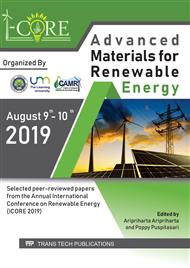p.149
p.156
p.164
p.172
p.184
p.197
p.205
p.212
p.220
Fourier Transform Infrared (FTIR) Spectroscopy and X-Ray Diffraction (XRD) Analysis of Synthetic Waste during Combustion Process
Abstract:
The availability of synthetic waste (SW) continuously increases, but on the contrary fossil fuels resources always decrease. The potential of SW for alternative fuel is critical to investigate for overcoming the problem generated from its overabundance and to provide its value-added. In this study, the changes of the macromolecular and the mineralogical during the SW combustion processes were investigated by Fourier Transform Infrared (FTIR) spectroscopy and x-ray diffraction (XRD), respectively. The combustion has been performed by using thermogravimetric analyzer (TGA) at a heating rate of 10 °C/min, from 25 to 1000 °C, with 100 ml/min constant flowrate of air atmosphere. According to the TGA results, the decomposition stage of the sample can be identified as a function of temperature and time. From ambient temperatures to 293 °C the sample experienced the first decomposition process that was correlated with the moisture losses and light volatile release. Macromolecular changes occurred at the temperature 293 °C where functional group of C–H in methylene was decomposed due to the removal of volatile matter. From the temperature of 293 to 485 °C the sample underwent the second stage of decomposition. The XRD result showed that mineral changes occurred at the temperature of 485 °C where the KCl compound was formed. In line with the escalating temperature, SiO2 was decomposed at a temperature of 590 °C. The final stage occurred at the temperature 625 to 1000 °C indicated by constant of TG line. At 625 °C, XRD result indicated the significant increasing of the CaCO3 compound.
Info:
Periodical:
Pages:
220-227
Citation:
Online since:
July 2020
Authors:
Keywords:
Price:
Сopyright:
© 2020 Trans Tech Publications Ltd. All Rights Reserved
Share:
Citation:


